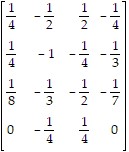Give the quadrant containing the point. If a point is on an axis, name the axis.(-4, 13)
A. QIII
B. QII
C. QIV
D. QI
Answer: B
You might also like to view...
Use the Gauss-Jordan method to find A-1, if it exists.A = 
A. 
B. 
C. 
D. Does not exist
Find the complete solution of the system.  figure 1.png)
What will be an ideal response?
The first card is not a two.
Two cards are dealt without replacement from a well-shuffled deck of cards. Find the probability of each event.
The vertices of a triangle are given. Use the distance formula to find what kind of triangle each is. A sketch of the graph might be helpful.
Note: An isosceles triangle has two equal sides. An equilateral triangle has three equal sides. A right triangle satisfies the Pythagorean Theorem. (6, 7), (4, 4), (6, 1) A) equilateral isosceles right B) isosceles C) right, not isosceles D) equilateral E) equilateral right